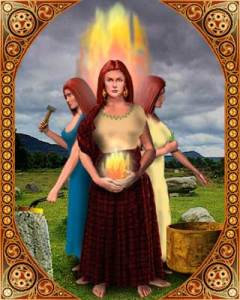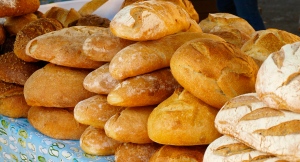 THE SABBAT LAMMAS
THE SABBAT LAMMAS
Lammas is the first of the harvest festivals, and if you live in the Northern Hemisphere, it begins August 1. This is one of modern Paganism’s Sabbats that has its roots in agricultural societies, and a time to celebrate the upcoming fall harvest. It’s the time of year when the first grains are threshed, bread is baked, and people begin storing up for the coming winter months. In some traditions, it’s also a season to honor Lugh, the craftsman god. Meanwhile, if you’re one of our Southern Hemisphere readers, you’re probably preparing for Imbolc, which honors the returning sun as spring looms around the corner. In many traditions, it’s a time to honor the goddess Brighid as well. Whichever one you’re ce lebrating, may you and your family have a joyful and blessed Sabbat!
lebrating, may you and your family have a joyful and blessed Sabbat!
What is Lammas (Lughnasadh)? – How to Celebrate Lammas
It’s the dog days of summer, the gardens are full of goodies, the fields are full of grain, and the harvest is approaching. Take a moment to relax in the heat, and reflect on the upcoming abundance of the fall months. At Lammas, sometimes called Lughnasadh, it’s time to begin reaping what we have sown throughout the past few months, and recognize that the bright summer days will soon come to an end.
At Lammas, also called Lughnasadh, the hot days of August are upon us, much of the earth is dry and parched, but we still know that the bright reds and yellows of the harvest season are just around the corner. Apples are beginning to ripen in the trees, our summer vegetables have been picked, corn is tall and green, waiting for us to come gather the bounty of the crop fields. Now is the time to begin reaping what we have sown, and gathering up the first harvests of grain, wheat, oats, and more. This holiday can be celebrated either as a way to honor the god Lugh, or as a celebration of the harvest.
Grain has held a place of importance in civilization back nearly to the beginning of time. Grain became associated with the cycle of death and rebirth. The Sumerian god Tammuz was slain and his lover Ishtar grieved so heartily that nature stopped producing. Ishtar mourned Tammuz, and
 followed him to the Underworld to bring him back, similar to the story of Demeter and Persephone.
followed him to the Underworld to bring him back, similar to the story of Demeter and Persephone.In early Ireland, it was a bad idea to harvest your grain any time before Lammas — it meant that the previous year’s harvest had run out early, and that was a serious failing in agricultural communities. However, on August 1, the first sheafs of grain were cut by the farmer, and by nightfall his wife had made the first loaves of bread of the season. The word Lammas derives from the Old English phrase hlaf-maesse, which translates to loaf mass. In early Christian times, the first loaves of the season were blessed by the Church.
Honoring Lugh, the Skillful God
In some Wiccan and modern Pagan traditions, Lammas is also a day of honoring Lugh, the Celtic craftsman god. He is a god of many skills, and was honored in various aspects by societies both in the British Isles and in Europe. Lughnasadh (pronounced Loo-NAS-ah) is still celebrated in many parts of the world today. Lugh’s influence appears in the names of several European towns.
In our modern world, it’s often easy to forget the trials and tribulations our ancestors had to endure. For us, if we need a loaf of bread, we simply drive over to the local grocery store and buy a few bags of prepackaged bread. If we run out, it’s no big deal, we just go and get more. When our ancestors lived, hundreds and thousands of years ago, the harvesting and processing of grain was crucial. If crops were left in the fields too long, or the bread not baked in time, families could starve. Taking care of one’s crops meant the difference between life and death.
The Wheel of the Year has turned once more, and you may feel like decorating your house accordingly. While you probably can’t find too many items marked as “Lammas decor” in your local discount store, there are a number of items you can use as decoration for this harvest holiday.
- Sickles and scythes, as well as other symbols of harvesting
- Grapes and vines
- Dried grains — sheafs of wheat, bowls of oats, etc.
- Corn dolls — you can make these easily using dried husks
- Early fall vegetables, such as squashes and pumpkins
- Late summer fruits, like apples, plums and peaches
Crafts, Song and Celebration
Because of its as sociation with Lugh, the skilled god, Lammas (Lughnasadh) is also a time to celebrate talents and craftsmanship. It’s a traditional time of year for craft festivals, and for skilled artisans to peddle their wares. In medieval Europe, guilds would arrange for their members to set up booths around a village green, festooned with bright ribbons and fall colors. Perhaps this is why so many modern Renaissance Festivals begin around this time of year! Lugh is also known in some traditions as the patron of bards and magicians. Now is a great time of year to work on honing your own talents. Learn a new craft, or get better at an old one. Put on a play, write a story or poem, take up a musical instrument, or sing a song. Whatever you choose to do, this is the right season for rebirth and renewal, so set August 1 as the day to share your new skill with your friends and family.
sociation with Lugh, the skilled god, Lammas (Lughnasadh) is also a time to celebrate talents and craftsmanship. It’s a traditional time of year for craft festivals, and for skilled artisans to peddle their wares. In medieval Europe, guilds would arrange for their members to set up booths around a village green, festooned with bright ribbons and fall colors. Perhaps this is why so many modern Renaissance Festivals begin around this time of year! Lugh is also known in some traditions as the patron of bards and magicians. Now is a great time of year to work on honing your own talents. Learn a new craft, or get better at an old one. Put on a play, write a story or poem, take up a musical instrument, or sing a song. Whatever you choose to do, this is the right season for rebirth and renewal, so set August 1 as the day to share your new skill with your friends and family.
Lammas Rituals and Ceremonies
Lammas is the first of three Pagan harvest festivals, and takes place on August 1, right around the time of the early grain harvests.The fields are full of grain, and the harvest is approaching. Take a moment to relax in the heat, and reflect on the upcoming abundance of the fall months. At Lammas, sometimes called Lughnasadh, it’s time to begin reaping what we have sown throughout the past few months, and recognize that the bright summer days will soon come to an end.
Celebrate with rituals and ceremonies to honor the harvest
Decorate Your Lammas Altar
Lammas Harvest Ritual
Ritual to Honor Lugh
Bread Sacrifice Ceremony
Lammas Prayers
Lammas History and Folklore
Grain has held an important place in the role of human development and society. Because of its growth patterns, it has often been associated with the cycle of life, death, and rebirth. Read on to learn about the ways different cultures have honored and mythologized grain and the spirit of the harvest.
Lammas History
Deities of the Fields
Legends and Lore of Lammas
Lugh, Master of Skills
The Legend of John Barleycorn
The Final Sheaf
The Spirit of the Grain
All About Imbolc
Imbolc is a time to celebrate the end of winter, and the goddess Brighid. If you live in the Southern Hemisphere, Aug ust 1 marks this Sabbat for you. Learn about the history and folklore behind this holiday, as well as some rituals you can do to welcome the season! Read All About Imbolc.
ust 1 marks this Sabbat for you. Learn about the history and folklore behind this holiday, as well as some rituals you can do to welcome the season! Read All About Imbolc.
Lammas Magic
Lammas is a good time to get in touch with one’s inner warrior, and get focused on magic relating to protection. Learn about different types of protection magic, and how you can use everyday items in your magical Lammas workings.
Warrior Meditation
Ash Tree Magic
Protection Magic
Onion Magic
Magical Vervain Water
Today’s message is from About.com by Patti Wigington, your Guide to Paganism / Wiccan.
Learn about Lughnasadh


Wonderful Post 😀
Thought you might like my machinima film,
The Lammas Wickerman
Bright Blessings
Elf
/|\